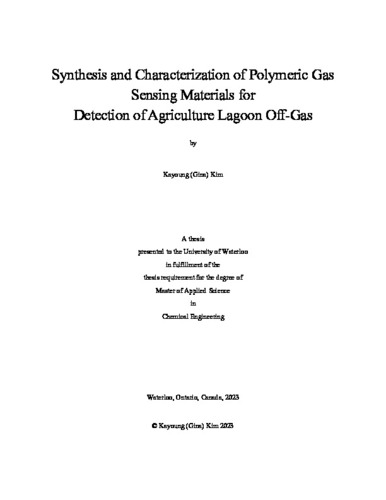| dc.description.abstract | With increasing food demand, agriculture and farming industry have grown. This led to an increase in production of agricultural waste. The waste is converted into manure via anaerobic fermentation which continuously produces biogas. Every year, a large volume of biogas-containing pollutants, including greenhouse gases (GHG), are released from manure fermentation.
To monitor the progress of manure fermentation and control gas pollutants released into the atmosphere, a sensor that can detect components of biogas in a continuous and reliable manner is necessary. For a more economic system, the sensor should be able to operate at room temperature (roughly, 22-25℃ range) and specifically detect certain gas analytes.
Methane and ammonia are selected as the target gases for detection because of their significance. Methane is a small molecule hydrocarbon and very potent greenhouse gas. At high concentrations, there is a possibility of combustion and asphyxiation, thus monitoring its presence and concentration is essential. Ammonia is the main source of odor from manure fermentation and can be toxic at a low concentration. As both target gases are toxic and reactive, formaldehyde was used as a “simulant” or “surrogate” gas (a less hazardous gas) for preliminary in-lab testing of sensing material sensitivity with the gas chromatography (GC) set-up.
Any sensor requires a sensing material that responds to one specific gas analyte. Polyaniline (PANI), polypyrrole (PPy), and polydimethylsiloxane (PDMS) have been indicated in the literature to exhibit affinity for ammonia and/or methane. They were tested first with gas chromatography (GC) using formaldehyde. Out of the three, PANI showed better sensing capabilities.
Tin (IV) oxide, zinc oxide, sodium dodecyl sulphate, titanium (IV) oxide and hydrochloric acid were selected as the top 5 dopants for polyaniline. PANI was synthesized in the lab with varying dopant levels for GC testing. Scanning electron microscopy (SEM), energy-dispersive X-ray spectroscopy (EDX), X-ray diffraction (XRD), and ultraviolet-visible (UV-Vis) spectroscopy were used to further characterize the synthesized materials for their physical and chemical properties.
PANI doped with 2.5% ZnO-sodium dodecyl sulfate (SDS) showed higher sensitivity for sensing formaldehyde as it had the greatest response (sorption) at a low concentration. ZnO incorporation into PANI was poor. When SDS was added, ZnO incorporation improved, which led to higher gas sorption. The notable interaction of SDS and ZnO could be scrutinized further if the formulation needs to be optimized for best ZnO incorporation without sacrificing the PANI structure.
When tested with the actual micro-electrical-mechanical system (MEMS) sensor at 50 ppm methane source (test chamber in System Design Engineering), both PANI with 5% SnO2 and 5% ZnO sorbed methane at room temperature. PANI-5% ZnO was proven to be the most suitable sensing material for methane detection, showing the highest signal at 50 ppm methane levels. | en |

